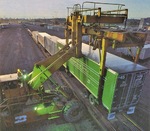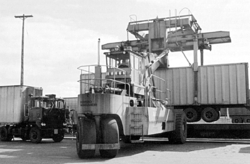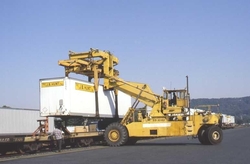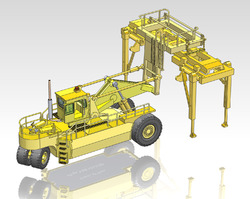PC-90 Update & Shades of the Old SP
 Tuesday, July 26, 2011 at 07:52PM
Tuesday, July 26, 2011 at 07:52PM  Tuesday, July 26, 2011 at 07:52PM
Tuesday, July 26, 2011 at 07:52PM  Thursday, July 7, 2011 at 09:22PM
Thursday, July 7, 2011 at 09:22PM Come to the National Train Show! If you are in Sacramento, CA, this Friday through Sunday, be sure to stop by Wheels of Time booth at the NMRA National Train Show. Wheels of Time booth is #303.
Go here for more details - http://www.nationaltrainshow.org/2011/sacramento.html
 Friday, June 17, 2011 at 04:06PM
Friday, June 17, 2011 at 04:06PM Wheels of Time is looking forward to the Fall, 2011 release of its brand new PC-90 Piggy-Packer, a large, purpose-built tractor that has served the railroads' intermodal scene for almost 45 years. Read our short history of this interesting machine below, and learn more about the Wheels of Time PC-90 Piggy-Packer on our product pages. Enjoy!
 Burlington Northern PC-90 Piggy-Packer at Portland (Paul Brezicki photo collection)
Burlington Northern PC-90 Piggy-Packer at Portland (Paul Brezicki photo collection)
By the early 1960s, railroads in North America were routinely transporting truck trailers on specialized railroad cars called “piggyback” flat cars (known as Trailer On Flat Car, or TOFC). The loading and unloading of truck trailers from these flat cars was accomplished by way of a ramp at one end of the train, with a truck-tractor used to pull the trailer on and off the train. This was commonly referred to as “circus loading”, and was a time consuming process: by this method, trailers on piggyback flat cars could only be loaded or unloaded sequentially. Furthermore circus loading required a very skilled driver, one able to navigate the narrow confines of a flatcar, especially when backing up to pick up a trailer.
In 1964, the Southern Pacific Railroad (SP) began searching for ways to speed up operations at its LA piggyback facility know as LATC or “Shops”. Inspiration came in the form of a log-loading machine in Oregon called the “Lumberjack”, a large tractor with oversize tires built by FWD Wagner Corp., and modified by Nelson Equipment Co., the sales agent for Wagner in Portland, OR. SP worked with Nelson to further modify the loader to handle trailers. After testing various configurations at LATC and Brooklyn Yard in Portland, the prototype machine, called the “Model 60”, entered service at LATC. The lifting device had a pair of short forks and a pivoting arm that engaged the trailer floor from the opposite side.
The production model was called the P-70, came with a 70,000 lb lift capacity, and featured an extended-width grapple frame. The first P-70 was sold to Milwaukee Road for its Bensenville, IL (Franklin Park) facility in October, 1966. Shortly after came the largest-ever single order for the Piggy-Packer: 14 P-70’s for the NYC. The Central had realized that the Flexivan was a dead-end technology, and that improved clearances east of Albany were facilitating the conversion to TOFC. The Central decided that the Piggy-Packer was superior to the crane lift because the terminals required little or no modifications. However, the P-70 had it’s drawbacks. It tended to tilt the trailer as it was being lifted causing loads to shift on the inside. Further, it required a 10-ft clearance on the far side of the trailer due to the pivoting grapple frame.
 Southern Pacific PC-90 loading a Seatrain container. (Matthew Young photo collection)
Southern Pacific PC-90 loading a Seatrain container. (Matthew Young photo collection)
 Erie Lackawanna PC-90 Piggy-Packer loading trailers in Chicago. (Paul Brezicki photo collection)In 1968, the FWD Wagner Corp. developed the P-80 and the PC-90. The boom on the PC-90 (and P-80) was redesigned to eliminate the tilting of the trailers during lifting by including a pair of horizontal stabilizing bars that served as a parallelogram. Folding grapple arms replaced the clamshell lift mechanism, eliminating the 10-feet clearance required with the '70. Further, by 1968, ISO standards had been established for the emerging maritime container business, replacing the proprietary lift mechanisms for SeaLand, Matson and others. Nelson saw the growth potential in adapting the Piggy-Packer for container handling, and chose the lift mechanism that had been developed by Ropco Corp. The first dual-purpose machine equipped with a container spreader entered service in UP’s Seattle facility in 1968. Furthermore, lift capacity was beefed up to 90,000 lb (45 tons). The PC-90 quickly became the de facto standard for mechanization of TOFC operations.
Erie Lackawanna PC-90 Piggy-Packer loading trailers in Chicago. (Paul Brezicki photo collection)In 1968, the FWD Wagner Corp. developed the P-80 and the PC-90. The boom on the PC-90 (and P-80) was redesigned to eliminate the tilting of the trailers during lifting by including a pair of horizontal stabilizing bars that served as a parallelogram. Folding grapple arms replaced the clamshell lift mechanism, eliminating the 10-feet clearance required with the '70. Further, by 1968, ISO standards had been established for the emerging maritime container business, replacing the proprietary lift mechanisms for SeaLand, Matson and others. Nelson saw the growth potential in adapting the Piggy-Packer for container handling, and chose the lift mechanism that had been developed by Ropco Corp. The first dual-purpose machine equipped with a container spreader entered service in UP’s Seattle facility in 1968. Furthermore, lift capacity was beefed up to 90,000 lb (45 tons). The PC-90 quickly became the de facto standard for mechanization of TOFC operations.
 Conrail PC-90 Piggy-Packer loading a JB Hunt trailer at Harrisburg-TV yard. (Paul Brezicki photo)With the commercial success of the Piggy-Packer well-established, FWD Wagner was reluctant to assume all manufacturing and development. By the end of 1968, FWD Wagner sold all aspects of the Piggy-Packer to the Raygo Corp., a heavy equipment manufacturer. Raygo went on to develop the Piggy-Packer as a part of the Raygo Wagner intermodal product line. They were fabricated in Portland with parts made by Clark. By the late 1970’s, Piggy-Packers were being built under contract, by Portland-based Allied Systems Inc. The line eventually included the following models:
Conrail PC-90 Piggy-Packer loading a JB Hunt trailer at Harrisburg-TV yard. (Paul Brezicki photo)With the commercial success of the Piggy-Packer well-established, FWD Wagner was reluctant to assume all manufacturing and development. By the end of 1968, FWD Wagner sold all aspects of the Piggy-Packer to the Raygo Corp., a heavy equipment manufacturer. Raygo went on to develop the Piggy-Packer as a part of the Raygo Wagner intermodal product line. They were fabricated in Portland with parts made by Clark. By the late 1970’s, Piggy-Packers were being built under contract, by Portland-based Allied Systems Inc. The line eventually included the following models:
• Piggy-Packers: PC-90 with a 90,000 lb lift capacity; PC-80 with a 80,000 lb lift capacity. The PC-80 had a shorter wheelbase than PC-90.
• Port Packers: MH-80 with 80,000 lb lift capacity; CH(E)-70 with 70,000 lb lift capacity; CH-50 with 50,000 lb lift capacity. The Port Packers were similar to the PC-90, but had a shorter wheelbase, slightly higher operator's cab, and a detachable spreader for lifting containers.
• Stac-Pac: Stac-Pac were developed and used by the Southern Pacific in lifting containerized automobiles on to railroad flat cars. Auto containers were open at the ends and held GM autos three high. They had a revolving mechanism that rotated horizontally to facilitate the loading of autos into the container and then rotated the container 90 degrees to be placed on a railroad flat car. It seems that the SP tried using PC-90s for lifting these short open-ended auto containers but the operation required more maneuverability than the '90 had.
In the North American market, the PC-90 had competition in the Marathon LeTourneau "LeTro-Porters", which were powered by a diesel-electric drive system much like a locomotive, and had a winch-lift system. A number of railroads used the LeTro-Porters, including the Santa Fe Railway, to supplement their overhead-lift cranes.
 CSX "Seaboard System" PC-90 Piggy-Packer in Charlotte, NC (Paul Brezicki photo)In 1985, the Mi-Jack Corporation, manufacturer of overhead-lift TOFC/COFC equipment (Translift and Travelift), added sideloaders to its product line by acquiring the the Raygo-Wagner line of Piggy-Packers and Port Packers. Mi-Jack continued the arrangement with Allied (which, in 2011, still produces several versions of the machine that started it all … the Lumberjack, with various lift capacities). The PC-90 lives on as the MJ-9090, Mi-Jack’s current boom-style sideloader.
CSX "Seaboard System" PC-90 Piggy-Packer in Charlotte, NC (Paul Brezicki photo)In 1985, the Mi-Jack Corporation, manufacturer of overhead-lift TOFC/COFC equipment (Translift and Travelift), added sideloaders to its product line by acquiring the the Raygo-Wagner line of Piggy-Packers and Port Packers. Mi-Jack continued the arrangement with Allied (which, in 2011, still produces several versions of the machine that started it all … the Lumberjack, with various lift capacities). The PC-90 lives on as the MJ-9090, Mi-Jack’s current boom-style sideloader.
Read about our PC-90 on the product pages. Our Piggy-Packer is an accurate model of this great machine.
 FWD Wagner,
FWD Wagner,  PC-90,
PC-90,  Piggy-Packer,
Piggy-Packer,  Raygo,
Raygo,  Southern Pacific,
Southern Pacific,  TOFC |
TOFC |  Email Article
Email Article  Friday, June 17, 2011 at 03:46PM
Friday, June 17, 2011 at 03:46PM  PC-90 from above, with raised boom (Wheels of Time image)After many (very enjoyable) hours of research and design, Wheels of Time is pleased to announce the Fall 2011 arrival of the Piggy-Packer, a large tractor for moving trailers and containers for TOFC/COFC operations. The Wheels of Time PC-90 Piggy-Packer is a highly detailed and historically accurate model based on the FWD Wagner / Raygo Wagner PC-90.
PC-90 from above, with raised boom (Wheels of Time image)After many (very enjoyable) hours of research and design, Wheels of Time is pleased to announce the Fall 2011 arrival of the Piggy-Packer, a large tractor for moving trailers and containers for TOFC/COFC operations. The Wheels of Time PC-90 Piggy-Packer is a highly detailed and historically accurate model based on the FWD Wagner / Raygo Wagner PC-90.
See more 3D models of Wheels of Time's PC-90, and some archival pics of the prototype, on the new Piggy-Packer product page.
In our next post, you'll read some of the interesting history of this great machine. Stay tuned!
 Intermodal,
Intermodal,  PC-90,
PC-90,  Piggy-Packer |
Piggy-Packer |  Email Article
Email Article  Monday, June 6, 2011 at 08:29PM
Monday, June 6, 2011 at 08:29PM A quick note here. We are shipping the 2nd batch of our 70-ft heavyweight baggage-express cars. If you have reserved them directly with us, we should be sending those out in a day or so. If you have reserved them, through your dealer, they should be receiving them within a week. PayPal shopping carts will be turned on for the extras we have in stock in about a week.

WARNING: CHOKING HAZARD: Small Parts - Not for children under 14 years. Wheels of Time products are not toys and are not intended for children under 14 years.
Copyright © 2025 Wheels of Time. All rights reserved. Products bearing Missouri Pacific, Chicago & North Western, Denver Rio Grande & Western, Union Pacific, Southern Pacific and Western Pacific marks are made under trademark license from Union Pacific Railroad Company.